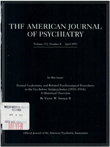The prediction of major depression in women: toward an integrated etiologic model
Abstract
OBJECTIVE: The authors develop an exploratory, integrated etiologic model for the prediction of episodes of major depression in an epidemiologic sample of women. METHOD: Both members of 680 female- female twin pairs of known zygosity from a population-based register were assessed three times at greater than 1-year intervals. The last two assessments included a structured interview evaluation for presence of episodes of major depression, defined by DSM-III-R, in the preceding year. The final structural equation model contained nine predictor variables: genetic factors, parental warmth, childhood parental loss, lifetime traumas, neuroticism, social support, past depressive episodes, recent difficulties, and recent stressful life events. RESULTS: The best-fitting model predicted 50.1% of the variance in the liability to major depression. The strongest predictors of this liability were, in descending order, 1) stressful life events, 2) genetic factors, 3) previous history of major depression, and 4) neuroticism. While 60% of the effect of genetic factors on the liability to major depression was direct, the remaining 40% was indirect and mediated largely by a history of prior depressive episodes, stressful life events, lifetime traumas, and neuroticism. The model suggested that at least four major and interacting risk factor domains are needed to understand the etiology of major depression: traumatic experiences, genetic factors, temperament, and interpersonal relations. CONCLUSIONS: Major depression is a multifactorial disorder, and understanding its etiology will require the rigorous integration of genetic, temperamental, and environmental risk factors.
Access content
To read the fulltext, please use one of the options below to sign in or purchase access.- Personal login
- Institutional Login
- Sign in via OpenAthens
- Register for access
-
Please login/register if you wish to pair your device and check access availability.
Not a subscriber?
PsychiatryOnline subscription options offer access to the DSM-5 library, books, journals, CME, and patient resources. This all-in-one virtual library provides psychiatrists and mental health professionals with key resources for diagnosis, treatment, research, and professional development.
Need more help? PsychiatryOnline Customer Service may be reached by emailing [email protected] or by calling 800-368-5777 (in the U.S.) or 703-907-7322 (outside the U.S.).



